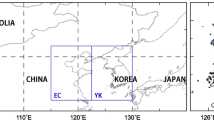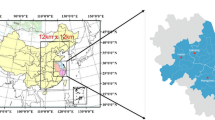Abstract
The occurrence and transport of dust storms and anthropogenic air pollutants in East Asia have been monitored using the meteorological satellite data of the National Oceanic and Atmospheric Administration (NOAA) and ground-based measurements at Cheongwon, a background observation site in central Korea. The nine cases, measured over 14 days, of natural dust particles caused by dust storms originating from northern China and Mongolia were observed at Cheongwon in the spring, autumn, and winter of 2010. In addition, seven cases, measured over 18 days, of anthropogenic dust particles originating from eastern China were observed over the course of a year. In those cases of natural and anthropogenic dust particles observed at Cheongwon, the level of particle matter (PM) with a diameter of ≤10 μm (PM10) (100 μgm−3 day−1) or PM2.5 (50 μgm−3 day−1) exceeded the air quality standards of Korea for 5 and 6 days, respectively. At the same time, CO concentrations rose higher due to long-range transport, while CO levels in the cases of anthropogenic dust particles (954 ppb) rose higher compared with the cases of natural dust particles (812 ppb). While gusty north–northwesterly winds were blowing in the front side of high-pressure systems, an increase in CO concentrations along with the influx of dust storms was observed at Cheongwon in the three natural dust particle cases with continental background airflow (n-CBAs). However, the other six natural dust particle cases with continental polluted airflow (n-CPAs) were also observed where mass concentrations of TSP, PM10 and PM2.5, and CO increased simultaneously after the CO concentrations rose and fell before dust storms had flowed in, showing double peaks. The mass concentrations of total suspended particle (TSP), PM10, and PM2.5 were high, and the PM2.5/TSP mass concentration ratio was high in n-CPAs, compared with n-CBAs. However, the anthropogenic dust particle cases with continental polluted airflow (a-CPA) are affected by air pollutants transported from eastern China by warm southwesterly winds, since central Korea is located in the rear side of the high-pressure system and in the foreside of the low-pressure system. Also, the anthropogenic dust particle cases with regionally polluted airflow (a-RPA) were observed in central Korea due to a stagnant high-pressure system for several days in the Yellow Sea region. In a-CPA, the mass concentrations of TSP, PM10, and PM2.5; the PM2.5/TSP mass concentration ratio; and the CO concentrations were all higher than in a-RPA.














Similar content being viewed by others
References
Akimoto H (2003) Global air quality and pollution. Science 302:1716–1719
Chung YS (1986) Air pollution detection by satellites: the transport and deposition of air pollutants over ocean. Atmos Environ 20:617–630
Chung YS, Kim HS (2008) Observations of massive air-pollution transport and associated air quality in the Yellow Sea region. Air Qual Atmos Health 1:69–79
Chung YS, Le HV (1984) Detection of forest-fire smoke plumes by satellite image. Atmos Environ 18:2143–2151
Draxler RR, Rolph GD (2003) HYSPLIT (HYbrid Single-Particle Lagrangian Integrated Trajectory) Model. Available online at: http://www.arl.noaa.gov/ready/hysplit4.html (accessed October 2013)
Gu Y, Rose WI, Bluth GJS (2003) Retrieval of mass and sizes of particles in dust storms using two MODIS IR bands: a case study of April 7, 2001 dust storm in China. Geophys Res Lett 30:1805. doi:10.1029/2003GL017405
Iino N, Kinoshita K, Tupper AC, Yano T (2004) Detection of Asian dust aerosols using meteorological satellite data and suspended particulate matter concentrations. Atmos Environ 38:6999–7008
Kim HS, Chung YS (2008) Satellite and ground observations for large-scale air pollution transport in the Yellow Sea region. J Atmos Chem 60:103–116
Kim YK, Song SK, Lee HW, Kim CH, Oh IB, Moon YS, Shon ZH (2006) Characteristics of Asian dust transport based on synoptic meteorological analysis over Korea. Air Waste Manag Assoc 56:306–316
Kim SW, Yoon SC, Kim J, Kim SY (2007) Seasonal and monthly variations of columnar aerosol optical properties over East Asia determined from multi-year MODIS, LIDAR and AERONET sun/sky radiometer measurements. Atmos Environ 41:1634–1651
Kim HS, Tans PP, Novelli PC (2008) On the regional background levels of carbon monoxide observed in East Asia during 1991 2004. Air Qual Atmos Health 1:37–44
Kim HS, Chung YS, Lee SG (2012) Characteristics of aerosol types during large-scale transport of air pollution over the Yellow Sea region and at Cheongwon, Korea, in 2008. Environ Monit Assess 184:1973–1984
Kim HS, Chung YS, Kim JT (2014) Spatio-temporal variations of optical properties of aerosols in East Asia measured by MODIS and relation to the ground-based mass concentrations observed in central Korea during 2001∼2010. Asia Pac J Atmos Sci 50:191–200
Kurosaki Y, Mikami M (2003) Recent frequent dust events and their relation to surface wind in East Asia. Geophys Res Let 30. doi:10.1029/2003GL017261
Lee JH, Kim J, Lee HC, Takemura T (2007) Classification of aerosol type from MODIS and OMI over East Asia. J Korean Meteor Soc 43:343–357
Li J, Han Z, Xie Z (2013) Model analysis of long-term trends of aerosol burdens and direct radiative forcings over East Asia. Tellus B 65:20410
Logan T, Xi B, Dong X, Li Z, Cribb M (2013) Classification and investigation of Asian aerosol absorptive properties. Atmos Chem Phys 13:2253–2265
Prata AJ (1989) Observations of volcanic ash clouds in the 10–12 μm window using AVHRR/2 data. Int J Remote Sens 10:751–761
Turnbull JC, Tans PP, Lehman SJ, Baker DF, Conway TJ, Chung YS, Gregg JS, Miller JB, Southon JR, Zhou L (2011) Atmospheric observations of carbon monoxide and fossil fuel CO2 emissions from East Asia. J Geophys Res 116:14. doi:10.1209/2011JD016691
Wang W, Fang ZY (2006) Numerical simulation and synoptic analysis of dust emission and transport in East Asia. Glob Planet Chang 52:57–70
Wen S, Rose WI (1994) Retrieval of sizes and total masses of particles in volcanic clouds using AVHRR bands 4 and 5. J Geophys Res 99:5421–5431
Acknowledgments
This study was carried out with a science subvention of the Korea Meteorological Administration, CATER (2012-6160).
Author information
Authors and Affiliations
Corresponding author
Rights and permissions
About this article
Cite this article
Kim, HS., Chung, YS. & Choi, HJ. On air pollutant variations in the cases of long-range transport of dust particles observed in central Korea in the leeside of China in 2010. Air Qual Atmos Health 7, 309–323 (2014). https://doi.org/10.1007/s11869-014-0238-y
Received:
Accepted:
Published:
Issue Date:
DOI: https://doi.org/10.1007/s11869-014-0238-y




